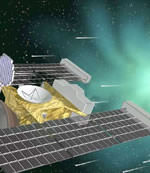
Image credit: NASA
NASA’s Stardust probe completed a minor course correction on Thursday, now only 198 days away from its destination: Comet Wild 2. The spacecraft fired its thrusters for 24 minutes and used up nearly 10% of its fuel. Stardust has traveled 2.9 billion kilometres since its launch in 1999, and if all goes well, it will reach the comet in January, 2004 and capture particles from its tail. It will then return the samples to Earth so they can be studied on the ground by scientists.
With 198 days before its historic rendezvous with a comet, NASA’s Stardust spacecraft successfully completed the mission?s third deep space maneuver. This critical maneuver modified the spacecraft?s trajectory, placing it on a path to encounter and collect dust samples from comet Wild 2 in January 2004.
At 2100 Universal Time (2:00 p.m. Pacific Time), Wed., June 18, Stardust fired its eight, 4.4 newton (1 pound) thrusters for a grand total of 1456 seconds, changing the comet sampler?s speed by 34.4 meters per second (about 77 miles per hour). This burn, the second in two days, completed the almost seven-year-long mission?s third deep space maneuver. The June 18 burn required 6.08 kilograms (13.4 pounds) of hydrazine monopropellant to complete. At launch, the spacecraft carried 85 kilograms (187 pounds) of hydrazine propellant.
“It was a textbook maneuver,” said Robert Ryan, Stardust?s mission manager at NASA?s Jet Propulsion Laboratory, Pasadena, Calif. “This was the last big burn we will have prior to our encounter with Wild 2, and it looks very accurate. After sifting through all the post-burn data I expect we will find ourselves right on the money.”
Stardust has traveled over 2.9 billion kilometers (1.8 billion miles) since its February 7, 1999 launch. At present, it is hurtling through the cosmos at 124,300 kilometers per hour (77,200 miles per hour).
In January 2004, Stardust will fly through the halo of dust that surrounds the nucleus of comet Wild 2. The spacecraft will return to Earth in January 2006 to make a soft landing at the U.S. Air Force Utah Test and Training Range. Its sample return capsule, holding microscopic particles of comet and interstellar dust, will be taken to the planetary material curatorial facility at NASA’s Johnson Space Center, Houston, Texas, where the samples will be carefully stored and examined.
Stardust?s cometary and interstellar dust samples will help provide answers to fundamental questions about the origins of the solar system. More information on the Stardust mission is available at http://stardust.jpl.nasa.gov.
Stardust, a part of NASA’s Discovery Program of low-cost, highly focused science missions, was built by Lockheed Martin Astronautics and Operations, Denver, Colo., and is managed by the Jet Propulsion Laboratory, Pasadena, Calif., for NASA’s Office of Space Science, Washington, D.C. JPL is a division of the California Institute of Technology in Pasadena. The principal investigator is astronomy professor Donald E. Brownlee of the University of Washington in Seattle.
Original Source: NASA News Release
